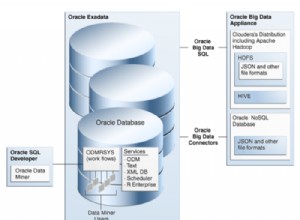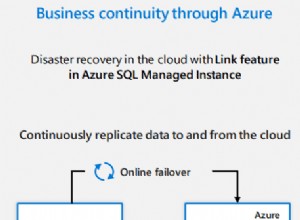Prima di questo articolo, tre articoli sono già stati pubblicati nella sezione "Linux Interview" e tutti sono stati molto apprezzati dai nostri lettori importanti, tuttavia stavamo ricevendo feedback per rendere questo processo di apprendimento interattivo, in sezione. Dall'idea all'azione, ti stiamo fornendo 15 domande di intervista MySQL .


1. Come verificheresti se il servizio MySql è in esecuzione o meno?
Risposta : Emetti il comando "service mysql status ” in 'Debian' e “stato del servizio mysqld ” in Red Hat. Controlla l'output e tutto fatto.[email protected]:/home/avi# service mysql status /usr/bin/mysqladmin Ver 8.42 Distrib 5.1.72, for debian-linux-gnu on i486 Copyright (c) 2000, 2013, Oracle and/or its affiliates. All rights reserved. Oracle is a registered trademark of Oracle Corporation and/or its affiliates. Other names may be trademarks of their respective owners. Server version 5.1.72-2 Protocol version 10 Connection Localhost via UNIX socket UNIX socket /var/run/mysqld/mysqld.sock Uptime: 1 hour 22 min 49 sec Threads: 1 Questions: 112138 Slow queries: 1 Opens: 1485 Flush tables: 1 Open tables: 64 Queries per second avg: 22.567.
2. Se il servizio è in esecuzione/fermo come vorresti interrompere/avviare il servizio?
Risposta : Per avviare il servizio MySql usa il comando come service mysqld start e per interrompere usa il servizio mysqld stop .[email protected]:/home/avi# service mysql stop Stopping MySQL database server: mysqld. [email protected]:/home/avi# service mysql start Starting MySQL database server: mysqld. Checking for corrupt, not cleanly closed and upgrade needing tables..
3. Come accederai a MySQL dalla shell di Linux?
Risposta : Per connetterti o accedere al servizio MySQL, usa il comando:mysql -u root -p .[email protected]:/home/avi# mysql -u root -p Enter password: Welcome to the MySQL monitor. Commands end with ; or \g. Your MySQL connection id is 207 Server version: 5.1.72-2 (Debian) Copyright (c) 2000, 2013, Oracle and/or its affiliates. All rights reserved. Oracle is a registered trademark of Oracle Corporation and/or its affiliates. Other names may be trademarks of their respective owners. Type 'help;' or '\h' for help. Type '\c' to clear the current input statement. mysql>
4. Come otterrai l'elenco di tutti i database?
Risposta : Per elencare tutti i database attualmente in esecuzione, esegui il comando sulla shell mysql come:mostra database;mysql> show databases; +--------------------+ | Database | +--------------------+ | information_schema | | a1 | | cloud | | mysql | | phpmyadmin | | playsms | | sisso | | test | | ukolovnik | | wordpress | +--------------------+ 10 rows in set (0.14 sec)
5. Come passerai a un database e inizierai a lavorarci?
Risposta : Per utilizzare o passare a un database specifico eseguire il comando sulla shell di mysql come:use database_name;mysql> use cloud; Reading table information for completion of table and column names You can turn off this feature to get a quicker startup with -A Database changed mysql>
6. Come otterrai l'elenco di tutte le tabelle, in un database?
Risposta : Per elencare tutte le tabelle di un database usa il comando su mysql shell come:mostra tabelle;mysql> show tables; +----------------------------+ | Tables_in_cloud | +----------------------------+ | oc_appconfig | | oc_calendar_calendars | | oc_calendar_objects | | oc_calendar_repeat | | oc_calendar_share_calendar | | oc_calendar_share_event | | oc_contacts_addressbooks | | oc_contacts_cards | | oc_fscache | | oc_gallery_sharing | +----------------------------+ 10 rows in set (0.00 sec)
7. Come otterrai il Nome campo e il Tipo di una tabella MySql?
Risposta : Per ottenere il Nome campo e il Tipo di una tabella usa il comando sulla shell di mysql come:descrivi nome_tabella;mysql> describe oc_users; +----------+--------------+------+-----+---------+-------+ | Field | Type | Null | Key | Default | Extra | +----------+--------------+------+-----+---------+-------+ | uid | varchar(64) | NO | PRI | | | | password | varchar(255) | NO | | | | +----------+--------------+------+-----+---------+-------+ 2 rows in set (0.00 sec)
8. Come eliminerai una tabella?
Risposta : Per eliminare una tabella specifica usa il comando sulla shell di mysql come:drop table nome_tabella;mysql> drop table lookup; Query OK, 0 rows affected (0.00 sec)
9. E il database? Come eliminerai un database?
Risposta : Per eliminare un database specifico utilizzare il comando sulla shell mysql come:drop database nome-database;mysql> drop database a1; Query OK, 11 rows affected (0.07 sec)
10. Come vedrai tutto il contenuto di una tabella?
Risposta : Per visualizzare tutto il contenuto di una particolare tabella usa il comando sulla shell di mysql come:select * from table_name;mysql> select * from engines; +------------+---------+----------------------------------------------------------------+--------------+------+------------+ | ENGINE | SUPPORT | COMMENT | TRANSACTIONS | XA | SAVEPOINTS | +------------+---------+----------------------------------------------------------------+--------------+------+------------+ | InnoDB | YES | Supports transactions, row-level locking, and foreign keys | YES | YES | YES | | MRG_MYISAM | YES | Collection of identical MyISAM tables | NO | NO | NO | | BLACKHOLE | YES | /dev/null storage engine (anything you write to it disappears) | NO | NO | NO | | CSV | YES | CSV storage engine | NO | NO | NO | | MEMORY | YES | Hash based, stored in memory, useful for temporary tables | NO | NO | NO | | FEDERATED | NO | Federated MySQL storage engine | NULL | NULL | NULL | | ARCHIVE | YES | Archive storage engine | NO | NO | NO | | MyISAM | DEFAULT | Default engine as of MySQL 3.23 with great performance | NO | NO | NO | +------------+---------+----------------------------------------------------------------+--------------+------+------------+ 8 rows in set (0.00 sec)
11. Come vedrai tutti i dati in un campo (ad esempio, uid), dalla tabella (ad esempio, oc_users)?
Risposta : Per visualizzare tutti i dati in un campo usa il comando su mysql shell come:select uid da oc_users;mysql> select uid from oc_users; +-----+ | uid | +-----+ | avi | +-----+ 1 row in set (0.03 sec)
12. Supponiamo di avere una tabella "xyz", che contiene diversi campi tra cui "create_time" e "motore". Il campo 'motore' è popolato con due tipi di dati 'Memoria' e 'MyIsam'. Come otterrai solo "create_time" e "engine" dalla tabella in cui il motore è "MyIsam"?
Risposta : Usa il comando sulla shell di mysql come:select create_time, engine from xyz where engine=”MyIsam”;12. mysql> select create_time, engine from xyz where engine="MyIsam"; +---------------------+--------+ | create_time | engine | +---------------------+--------+ | 2013-12-15 13:43:27 | MyISAM | | 2013-12-15 13:43:27 | MyISAM | | 2013-12-15 13:43:27 | MyISAM | | 2013-12-15 13:43:27 | MyISAM | | 2013-12-15 13:43:27 | MyISAM | | 2013-12-15 13:43:27 | MyISAM | | 2013-12-15 13:43:27 | MyISAM | | 2013-12-15 13:43:27 | MyISAM | | 2013-10-23 14:56:38 | MyISAM | | 2013-10-23 14:56:38 | MyISAM | | 2013-10-23 14:56:38 | MyISAM | | 2013-10-23 14:56:38 | MyISAM | | 2013-10-23 14:56:38 | MyISAM | | 2013-10-23 14:56:38 | MyISAM | | 2013-10-23 14:56:38 | MyISAM | +---------------------+--------+ 132 rows in set (0.29 sec)
13. Come mostrerai tutti i record della tabella "xrt" dove il nome è "tecmint" e l'indirizzo web è "tecmint.com"?
Risposta : Usa il comando sulla shell di mysql come:select * from xrt where name =“tecmint” e web_address =“tecmint.com”;mysql> select * from xrt where name = "tecmint" and web_address = “tecmint.com”; +---------------+---------------------+---------------+ | Id | name | web_address | +---------------+---------------------+----------------+ | 13 | tecmint | tecmint.com | +---------------+---------------------+----------------+ | 41 | tecmint | tecmint.com | +---------------+---------------------+----------------+
14. Come mostrerai tutti i record della tabella "xrt" in cui il nome non è "tecmint" e l'indirizzo web è "tecmint.com"?
Risposta : Usa il comando sulla shell di mysql come:select * from xrt where name !=“tecmint” e web_address =“tecmint.com”;mysql> select * from xrt where name != ”tecmint” and web_address = ”tecmint.com”; +---------------+---------------------+---------------+ | Id | name | web_address | +---------------+---------------------+----------------+ | 1173 | tecmint | tecmint.com | +---------------+---------------------+----------------+
15. È necessario conoscere il numero totale di voci di riga in una tabella. Come lo realizzerai?
Risposta : Usa il comando su mysql shell come:select count(*) from table_name;mysql> select count(*) from Tables; +----------+ | count(*) | +----------+ | 282 | +----------+ 1 row in set (0.01 sec)
È tutto per ora. Cosa ne pensi di questa "Domanda per l'intervista su Linux ' sezione. Non dimenticare di fornirci il tuo prezioso feedback nella nostra sezione commenti.




